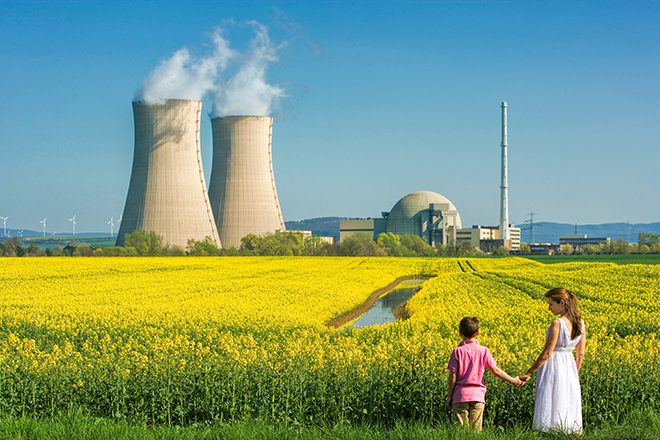Investing in nuclear energy: are we at a new dawn?
Portfolio Manager Tal Lomnitzer explains green energy, and explores the challenges and opportunities in uranium, an increasingly relevant topic for ESG investors.

7 minute read
Key takeaways:
- The European Commission has proposed to classify nuclear power as a sustainable activity under the EU Taxonomy Climate Delegated Act.
- The uranium market, which fuels nuclear power, has tightened considerably; sources of high quality, world class, socially and economically-viable uranium resources are increasing in demand.
- With a new surge in demand, there could be attractive investment opportunities in responsible resource companies, highlighting the role that active management can play.
Historically, fuel consumption has been on a modest scale, but growing urbanisation has led to rising fuel consumption by households, including wood, coal, coke and kerosene. This progressed to natural gas for heating and cooking in order to increase energy content and reduce indoor localised smoke. In cities, large, urbanised areas have suffered from pollution from coal-fired power stations, industrial processes, and vehicle pollution.
Globally, the total greenhouse gas (GHG) balance has been allowed to materially increase without penalty for a century, but with evidence of global climate, weather and ecological systems approaching or breaching their planetary boundaries because of anthropogenic, human-influenced GHG emissions, we have seen climate change agreements and regulation accelerating. The decarbonisation of the global economy is being facilitated by the provision of renewable electric energy from wind, solar and hydroelectric power, and in road transport the shift from hydrocarbon to battery electric power, with the ultimate aim of removing all pollution from fossil fuel combustion.
To be genuinely sustainable, an ideal energy source should be renewable ie. infinitely usable or replaceable to avoid depleting finite natural resources and polluting the environment.
Time to reconsider nuclear?
The European Union is trying to achieve several objectives simultaneously, these include the phasing out of coal, climate neutrality, lower reliance on imported natural gas, as well as greater energy independence and security. The attainment of these goals may be assisted by bringing nuclear power into the mix. The recent geopolitical turmoil surrounding Russia and the Ukraine only serves to magnify some of these issues. While natural gas has many positive benefits that has seen it rapidly displacing coal as a transitional energy source, it is still a non-renewable fossil fuel and cannot be considered truly green nor sustainable in its own right.
Nuclear power is considered by the Global Natural Resources Team to be much cleaner than natural gas, as it produces no greenhouse gases. It can be an excellent base load electricity supply, providing countries with dependable energy security, which historically was the case in the US, France, Germany, Japan, Russia, and South Korea. Furthermore, nuclear energy is typically produced in countries that are geopolitically stable. Wind, solar and hydro are cleaner than nuclear because they do not produce nuclear waste – ie. carbon dioxide when power is produced so are considered cleaner than using natural gas or coal. However, one issue is that these energy sources are intermittent and require storage and ‘spinning reserve’ for the energy grid to function effectively. Nuclear power is the only spinning reserve that does not produce greenhouse gases.
The problems with nuclear
The main impediments to nuclear power growth have been economics, waste management and public perception. Nuclear power plants are complex to build and operate. The projects generally take between five to ten years to build, are frequently delivered significantly over budget and behind schedule, with some failing to complete construction or obtain financing. However, these are engineering and funding issues, which can be overcome if there is the political will to include nuclear power in a country’s energy mix.
Nuclear power also remains controversial because of the risk of rogue production of nuclear weapons, the extremely long life of nuclear waste with its need for secure long-term storage, the economics of larger reactors and the environmental impact of nuclear accidents.
After the 2011 Tōhoku earthquake close to the east coast of Japan, the nuclear reactors there shut down successfully, but the tsunami very shortly afterwards flooded the nuclear plants and cut power to the electrical pumps resulting in three reactor units exploding. Following the disaster, many Japanese nuclear power plants remained offline; Japan’s experience has even caused ripple effects elsewhere, with Germany shutting down its reactors (and consequently is driving an increase in coal-fired power usage). Meanwhile, France remains committed to nuclear power, but has an ageing nuclear fleet of reactors with maintenance and safety issues to handle.
But there are solutions
These issues could potentially be resolved by shifting nuclear fuel from uranium to thorium, from which nuclear weapons cannot be made. This may take some time because thorium research has been underfunded so the focus is likely to remain on uranium for the foreseeable future. Smaller modular reactor (SMR) units can help mitigate the risk of accidents and have much lower upfront capital requirements, smaller footprints, lower water-cooling requirements, and are being designed with inherent passive safety features that would have avoided previous incidents such as those at the Fukushima and Three Mile Island in Pennsylvania nuclear plants. Finally, availability of secure storage can be increased for the long-lived waste, which while dangerous is relatively small in physical terms.
The key point is that there are unavoidable trade-offs everywhere within the energy system. A world powered only by renewable energy would be a wonderful thing but the harsh reality of managing a power grid is that a ‘spinning reserve’ is required to keep the system stable. This could be achieved with power storage (batteries), hydrogen or nuclear power, or most likely some combination of all.
Recognition of this seems to be rising with the European Commission’s recent announcement to classify nuclear power as green energy under the Taxonomy Regulation* that will be finalised later this year, as it seeks to eliminate coal, achieve net zero carbon, reduce the reliance on imported natural gas and increase energy independence. The European Taxonomy considers the full life cycle of uranium use and storage of the spent fuel, with Finland a world leader in nuclear energy generation highlighted by the country’s foresight and commitment to build the Onkalo spent nuclear fuel repository.
The proposed labelling of nuclear as a green energy comes with some caveats. Gas plants can be considered green if the facility switches to low-carbon or renewable gases, such as biomass or hydrogen produced with renewable energy, by 2035. Additionally, nuclear power plants must show how they will fund and safely manage and dispose of radioactive waste.
The uranium market
The uranium market has tightened considerably in the last year, with demand outstripping supply, resulting in higher prices. There has been depleting supply after a ten-year bear market (falling prices), alongside a lack of investment in new mine supply with a reduction in inventory accelerated by recently launched physical unit trusts similar to those seen in other metals.
The primary interest for our team is the discovery of high-quality, world-class, socially and economically viable uranium resources that can be mined in an environmentally-friendly way (underground ideally, via traditional or in-situ leaching). Such uranium sources are found in relatively few countries, primarily in Kazakhstan and Canada, and are essential to deliver uranium to fuel assembly plants to enable nuclear power generation.
Responsible miners
If nuclear energy usage does gain more traction, it is unlikely to be driven by thorium as uranium solutions are further advanced. Therefore newly-discovered deposits, such as NexGen Energy’s discovery in the South West Athabasca basin in Saskatchewan, Canada will be sorely needed. The Rook discovery in that area is particularly interesting because of its location in highly competent basement bedrock, which makes it amenable to bulk low-cost underground mining, with the tailings (benign mining by-products) used as backfill resulting in a minimal surface footprint.
Given the increasing focus on environmental, social and governance (ESG) considerations, resource companies also need to be responsible corporate citizens. NexGen has sought to incorporate landowner requirements into its development proposal, with a study agreement involving communities within the project area, demonstrating to investors a commitment to environmental stewardship, health & safety, reclamation, and community & indigenous relationships.
In summary
Given nuclear power’s probable green energy classification, fuels such as uranium could see a new surge in demand, and along with this may create some attractive investment opportunities. Rising demand needs to be met with responsible supply. Active management enables ESG factors to be actively incorporated into investment decisions as well as investor engagement. Investing in partnership with companies with a focus on ESG and effective stewardship makes sense as resource companies that have a strong focus on ESG considerations tend to be more appreciated by the market in the long run.
These are the views of the author at the time of publication and may differ from the views of other individuals/teams at Janus Henderson Investors. References made to individual securities do not constitute a recommendation to buy, sell or hold any security, investment strategy or market sector, and should not be assumed to be profitable. Janus Henderson Investors, its affiliated advisor, or its employees, may have a position in the securities mentioned.
Past performance does not predict future returns. The value of an investment and the income from it can fall as well as rise and you may not get back the amount originally invested.
The information in this article does not qualify as an investment recommendation.
Marketing Communication.
Important information
Please read the following important information regarding funds related to this article.
- Shares/Units can lose value rapidly, and typically involve higher risks than bonds or money market instruments. The value of your investment may fall as a result.
- Shares of small and mid-size companies can be more volatile than shares of larger companies, and at times it may be difficult to value or to sell shares at desired times and prices, increasing the risk of losses.
- The Fund is focused towards particular industries or investment themes and may be heavily impacted by factors such as changes in government regulation, increased price competition, technological advancements and other adverse events.
- The Fund follows a responsible investment approach, which may cause it to be underweight in certain sectors (due to the avoidance criteria employed) and thus perform differently than funds that have a similar financial objective but which do not apply any avoidance criteria when selecting investments.
- The Fund may use derivatives with the aim of reducing risk or managing the portfolio more efficiently. However this introduces other risks, in particular, that a derivative counterparty may not meet its contractual obligations.
- If the Fund holds assets in currencies other than the base currency of the Fund, or you invest in a share/unit class of a different currency to the Fund (unless hedged, i.e. mitigated by taking an offsetting position in a related security), the value of your investment may be impacted by changes in exchange rates.
- Securities within the Fund could become hard to value or to sell at a desired time and price, especially in extreme market conditions when asset prices may be falling, increasing the risk of investment losses.
- The Fund may incur a higher level of transaction costs as a result of investing in less actively traded or less developed markets compared to a fund that invests in more active/developed markets.
- The Fund could lose money if a counterparty with which the Fund trades becomes unwilling or unable to meet its obligations, or as a result of failure or delay in operational processes or the failure of a third party provider.
